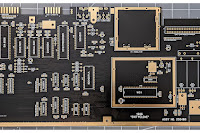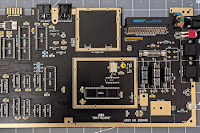
If you're like me, you may very well be keeping your camera's white balance on automatic. Whether this is down to ignorance or laziness (the latter in my case) I'm pretty certain this isn't wise so let's get into what white balance is and why it might be smart to think this through.
As we've found in my previous articles (coz you have read them all, right?) I do like to dig a bit into the sciency stuff so here goes...
The whole point of white balance is to make sure that an object which appears white to your eyes, still appears white in a picture you take of it. Why would that be a problem? Let's dig into this a bit. All of our natural light comes from the sun. The colour of sunlight is measured in something called Kelvin - which is actually a temperature scale. And why is this? Well because when you heat something up, the hotter it gets, the colour the object gives off starts to change. You will have heard the phrase that something can be "red hot", and something even hotter is "white hot" and that is exactly the idea we're getting at here. If you heat a black piece of metal it will start to go red, keep heating it and it will start to turn white and if it were possible to keep heating it further (without it melting) it would eventually start to turn blue. And that is the simplest way I can think of describing how colour temperature works - it's a logarithmic scale going from red to blue that gives an indication as to the temperature of something. Now out in space, if you were to look at the sun the colour temperature would be somewhere in the region of 5900 Kelvin (K). To our eyes, this will appear as very slightly yellow, nearly white.
However, we don't live in space, we live on a planet that is (luckily for us) thickly coated with lots of gasses and water vapour and when the sunlight interacts with these, the perceived colour of the sunlight is changed. The colour of the sun looks very different at dawn and dusk than it does when it is right above you at midday, and this is wholly due to the way the sunlight is interacting with the earth's atmosphere. All of these different colours are expressed in Kelvin. Sunrise and sunset have low colour temperatures (around 3200K) which is quite orange. A clear midday sun has a higher colour temperature of around 5500K which is much whiter. Cloudy days have a still higher colour temperature: the way sunlight refracts through water-vapour makes it quite blue, giving a hot colour temperature of around 7500K.
And just as the colour of the sun has different Kelvin values, so do our own light sources. Normal domestic incandescent light-bulbs cast an orange colour and have a low colour temperature of around 3000K. Fluorescent light bulbs are a little warmer coming in at around 4500K. All of this is very counterintuitive. We naturally think of hot objects as red and cool objects as blue, but in Kelvin, the opposite is true.
Because there is no consistent light, the colour of a white object will appear to be very different in any given lighting situation. It will seem very orange (cool) when viewed in a room with normal light-bulbs. It will seem very blue (hot) if viewed under cloudy skies. And this is where White Balancing comes in. It is simply the way the camera compensates for these different hot and cold colours and it does this by overlaying blue onto a cool (orange) scene or overlaying orange onto a hot (blue) scene. And it will overlay different amounts of these colours depending on how cold or hot a scene is.
 |
| Approximate placement of light conditions on the Kelvin scale |
The diagram above is a very simple approximation of where different lighting conditions appear on the Kelvin Scale. The icons to the right are representative of the icons your camera will have in its white balancing menu and in any of the conditions described (cloudy; noon, fluorescent light; domestic tungsten light) by setting your white balance to that condition, the camera should effectively compensate and the whites that you see with your eyes (which do a very good job of naturally compensating for these changes) should be replicated in the camera.
All of that said, nine times out of ten, your camera's Auto white balance setting will do a perfectly good job and I must confess my camera's white balance stays on Auto, almost all the time. However, that's because I shoot in RAW and I can change the colour temperature in my post processing software whenever I like. If you shoot in JPEG then the white balance setting is baked in and you can't change it later so if this is you, you may want to take a few moments and work out which setting is doing the best job of giving you the colours you want. Please bear in mind you can be creative with this - if you want a warmer scene or a cooler scene you can deliberately change the white balance to do this for you, so that's one very obvious reason why you might want to take control of white balance.
If accurate white balance is important to you, there is another way and that is by using a "Grey Card". These can be picked up very cheaply and are exactly as the name implies - a grey card, specifically, 18% grey and available in different sizes to suit your needs and budget. Using them couldn't be simpler - you just put the grey card in the scene you want to capture, take a picture with the grey card in it, then remove the card and take your shot. In your post processing software you simply open the photo with the grey card and by using the white balancing tool, select the grey card which will then make the necessary adjustment for you. You then synchronise or replicate those changes in the rest of your pictures and the job is done. Of course you need to remember to take another picture with the grey card every time you change location or if the lighting conditions change. And you need to remember to carry your grey card with you. I am terrible at remembering I actually have one.
There is yet another way and this is by setting a custom white balance in your camera. Interchangeable Lens Cameras (ILCs) and high end point and shoots should allow this. All manufacturers do this differently and you should consult your manual. This is not something I've ever done as it just seems too damn awkward but the option is there for you if this is of interest.
All of that said, nine times out of ten, your camera's Auto white balance setting will do a perfectly good job and I must confess my camera's white balance stays on Auto, almost all the time. However, that's because I shoot in RAW and I can change the colour temperature in my post processing software whenever I like. If you shoot in JPEG then the white balance setting is baked in and you can't change it later so if this is you, you may want to take a few moments and work out which setting is doing the best job of giving you the colours you want. Please bear in mind you can be creative with this - if you want a warmer scene or a cooler scene you can deliberately change the white balance to do this for you, so that's one very obvious reason why you might want to take control of white balance.
If accurate white balance is important to you, there is another way and that is by using a "Grey Card". These can be picked up very cheaply and are exactly as the name implies - a grey card, specifically, 18% grey and available in different sizes to suit your needs and budget. Using them couldn't be simpler - you just put the grey card in the scene you want to capture, take a picture with the grey card in it, then remove the card and take your shot. In your post processing software you simply open the photo with the grey card and by using the white balancing tool, select the grey card which will then make the necessary adjustment for you. You then synchronise or replicate those changes in the rest of your pictures and the job is done. Of course you need to remember to take another picture with the grey card every time you change location or if the lighting conditions change. And you need to remember to carry your grey card with you. I am terrible at remembering I actually have one.
There is yet another way and this is by setting a custom white balance in your camera. Interchangeable Lens Cameras (ILCs) and high end point and shoots should allow this. All manufacturers do this differently and you should consult your manual. This is not something I've ever done as it just seems too damn awkward but the option is there for you if this is of interest.



